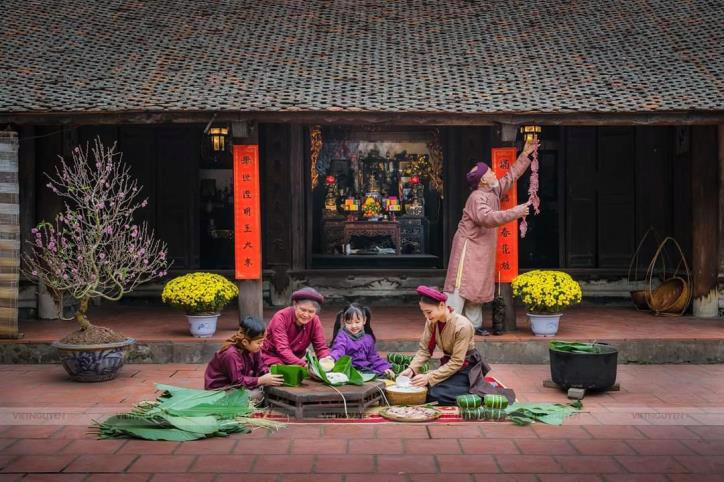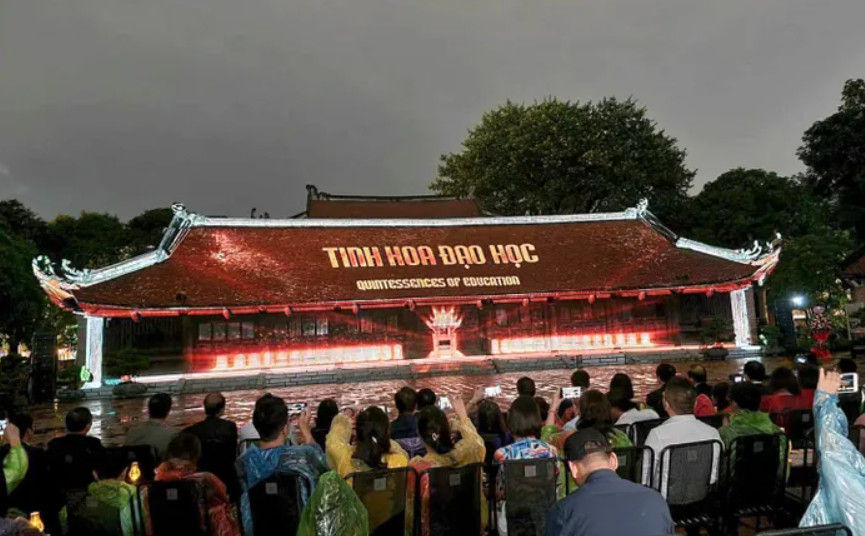Regional Vietnam Tet Customs: A Journey Through Diverse Traditions
- Trạm Review
.png/v1/fill/w_320,h_320/file.jpg)
- Dec 27, 2023
- 5 min read
Vietnam takes pride in its rich cultural traditions and unique customs, with Tet Nguyen Dan standing out as a hallmark of the nation's identity. Notably, the cultural practices during the traditional Tet celebration vary across the three regions of the country, encompassing distinct differences in clothing, festivities, daily activities, and festivals. The following provides a glimpse into the cultural nuances and customs of the northern, central, and southern regions during the Vietnam Tet Customs, showcasing the diversity that makes Vietnam's Tet celebrations truly special.
Northern Region Tet Customs
In the Northern region, Tet is a time of vibrant colors, cultural symbolism, and heartfelt traditions that contribute to a joyous and meaningful Lunar New Year celebration.
Tet flower arrangements
When it comes to traditional Tet celebrations in the Northern region, one of the striking aspects is the meticulous arrangement of Tet flowers. People in the North choose fresh branches of peach blossoms and kumquat trees, symbolizing vitality and prosperity. Legend has it that these flowers connect with an ancient peach tree on a remote mountain, said to protect villages during times of trouble. The vibrant colors and fragrant blossoms are not only decorative but also hold cultural significance, bringing joy and optimism to households during the Lunar New Year.

Traditional altar decoration during Tet
The traditional Tet altar in Northern households is adorned with profound symbolism. An essential part of Tet preparations is the altar setup, where offerings are made to honor ancestors. The altar is embellished with symbolic items, including traditional family photos, rice cakes (banh chung), and colorful fresh flowers. Each element represents cultural values, filial piety, and the hope for a prosperous and harmonious new year.
Representative Tet specialties
In Northern Vietnam, Tet celebrations are incomplete without a rich and diverse array of traditional dishes. The Tet feast typically features banh chung (square glutinous rice cake), boiled chicken, spring rolls (cha gio), pickled onions, and various side dishes. Banh chung, with its square shape symbolizing the Earth, is considered the soul of the Tet feast, reflecting a deep connection to ancestral roots and cultural heritage.
Unique Tet customs in the northern region
The Northern region has preserved unique Tet customs that distinguish it from other parts of Vietnam. People in the North eagerly anticipate the custom of wrapping banh chung together, a communal activity that fosters unity and reinforces familial bonds. Additionally, the practice of choosing and displaying peach blossoms during Tet carries both historical significance and aesthetic value, adding a distinctive touch to the celebrations.
Central Region Tet Customs
Tet celebrations in Central Vietnam are a harmonious blend of simplicity, authenticity, and a profound connection to nature.
Tet flower arrangements
In the Central region, Tet celebrations are marked by distinctive flower arrangements that showcase the local charm. During the cold mornings and warm afternoons of Tet, various flowers, especially chrysanthemums and marigolds, bloom throughout the streets. Peach blossoms from the North and apricot blossoms from the South add vibrant hues to households. The tradition of displaying flowers symbolizes the hope for prosperity and good fortune in the upcoming year, creating a picturesque landscape during Tet.

Traditional altar decoration during Tet
Central Vietnam adds its unique touch to Tet altar decorations. While honoring ancestors, families in the Central region emphasize simplicity and authenticity. The centerpiece of the altar is often the traditional Tet cake called "banh tet," representing the Earth with its cylindrical shape. It is a common belief in the Central region to avoid tasting the food before offering it to ancestors, ensuring that they get the first taste. Despite occasional culinary challenges, this practice is a heartfelt gesture of respect for ancestors.
Representative Tet specialties
Unlike the Northern region, Tet feasts in Central Vietnam feature a variety of rustic and enticing specialties. Common dishes include plain rice, braised fish, boiled chicken, fried spring rolls, vermicelli soup, and fresh vegetables. "Banh tet," a cylindrical glutinous rice cake filled with mung beans and pork, holds a special place on Tet altars in Central households. The tradition of presenting a "banh tet" to ancestors signifies a connection to ancestral roots and cultural values unique to the Central region.
Unique Tet customs in the northern region
Central Vietnam, facing natural disasters like storms and floods, incorporates a heartfelt wish for abundance and warmth into the Tet celebrations. Families in this region place a significant emphasis on the "mam ngu qua" or the tray of five fruits, aiming for a year of plenty and sufficiency. Additionally, influenced by Southern traditions, Central families might include bananas, mangos, custard apples, coconuts, and papayas on the tray. The avoidance of bitter oranges and tangerines on Tet trays is a distinct feature, as they are seen as symbols of hardship and endurance.
Southern Region Tet Customs
In the vibrant tapestry of Tet customs, the Southern region of Vietnam weaves a unique celebration marked by simplicity in feasts.
Tet flower arrangements
In the Southern region, where Tet coincides with the dry season, the simplicity of Tet feasts aligns with the hot weather. Southern families opt for cool dishes on their Tet tables, and the main trio comprises "banh tet" (cylindrical glutinous rice cake), rice paper, and braised pork. "Banh tet" holds a symbolic place, representing continuity and warmth across generations. The violet hue of "bánh tét tím," made from magenta leaves, adds both flavor and beauty, becoming an indispensable part of Southern Tet celebrations. Accompanying "banh tet" is "thịt kho tàu" (braised pork), selected from the finest cuts, simmered with coconut water, and often served with a side of fresh vegetables and rice paper rolls. These dishes are typically reserved for offerings or enjoyed until the afternoon of the second day of Tet. On the third day, Southern families switch to chicken, fish, beef, and sometimes indulge in Tet-specific dishes like "cháo cá ám" (fish congee) or grilled snakehead fish.

Traditional altar decoration during Tet
Mai flowers, an integral part of Southern households during Tet, play a crucial role in setting the festive atmosphere. In the days leading up to Tet, families diligently seek out the most suitable apricot blossom tree to adorn their homes. Mai flowers, with their elegant and resilient qualities, symbolize the spirit of Tet, standing firm against challenges just as a beautiful girl would. Similar to the significance of peach blossoms in the North, Tet without mai flowers in the South feels incomplete, akin to missing the arrival of a beautiful girl heralding spring into every home.
Representative Tet specialties
In Southern Vietnam, the Tet tray of five fruits, known as "mâm ngũ quả," is presented with artistic flair. While in the North, various fruits, including spicy chili, may find a place on the tray as long as they look aesthetically pleasing, Southerners are more cautious in their choices. Bananas are notably absent due to the phonetic resemblance of "chuối" to "nguy khó" (difficulty), and oranges are avoided due to the phrase "quýt làm, cam chịu" (bitter orange makes you frown). Given the abundance of fruit in the South, the Tet tray has evolved from a rigid "five fruits" concept to a more creative and diverse display, sometimes featuring up to ten fruits arranged artistically. Despite the variations, it remains known as "mâm ngũ quả," a cultural product firmly established in Southern history, shaped by the belief in the "perfect quintet" within the imaginative minds of Southern residents.
Unique Tet customs in the northern region
Tet in the South starts later than in the North and Central regions. People in the South are not overly meticulous about preparing for Tet, avoiding the hustle and bustle of early preparations. Tet for Southerners typically begins around three days before the first day of the Lunar New Year and extends until the full moon of the first lunar month. A distinctive Southern tradition is dedicating the first day of Tet, "mùng một tết cha" (the first day of Tet for fathers), to family. On this day, family members gather to wish their grandparents a happy Tet before engaging in festive activities or enjoying entertainment at various locations. The Southern Tet celebration is a unique blend of cultural practices, culinary delights, and a leisurely pace that captures the essence of family unity and joyful gatherings.
Contact Vietnam4seasons Travel
Hotline: (+84) 398 573 689
WhatsApp: (+84) 398 573 689
Email: vietnam4seasons@gmail.com




Comments